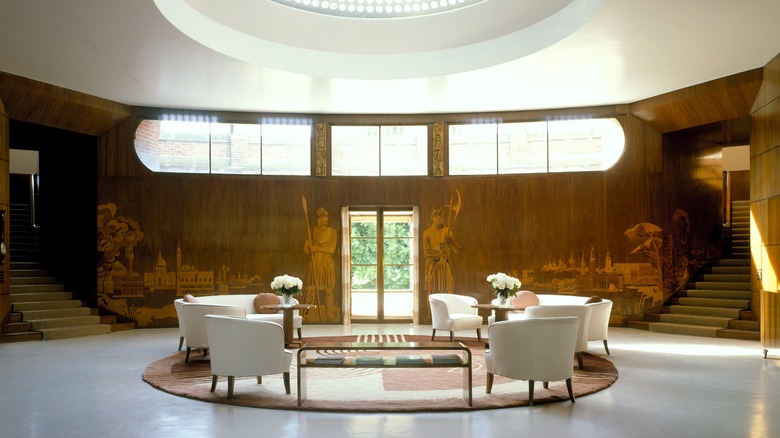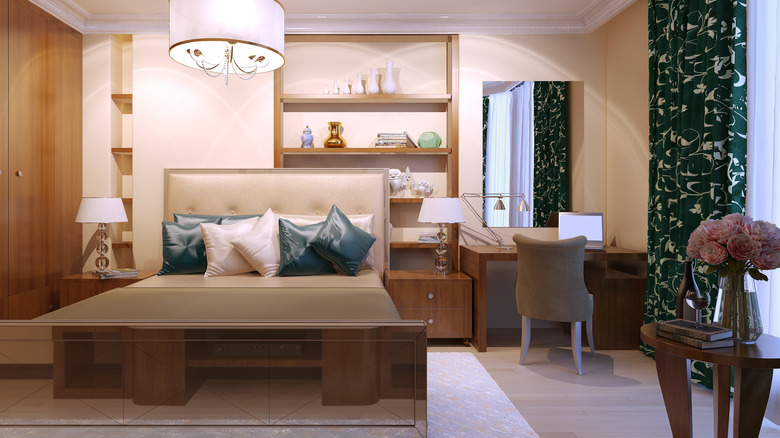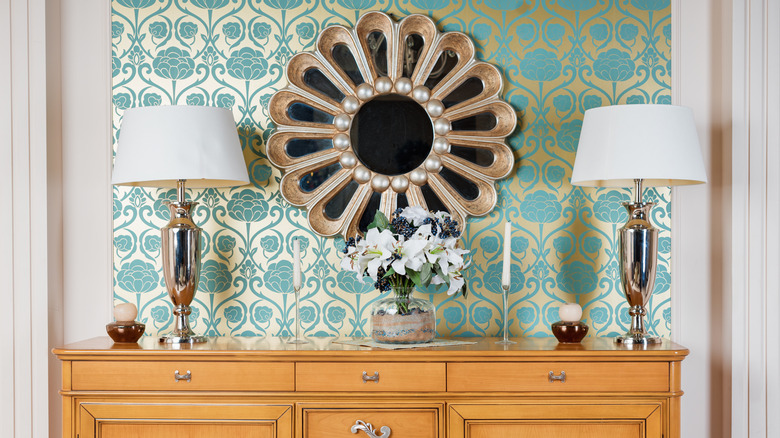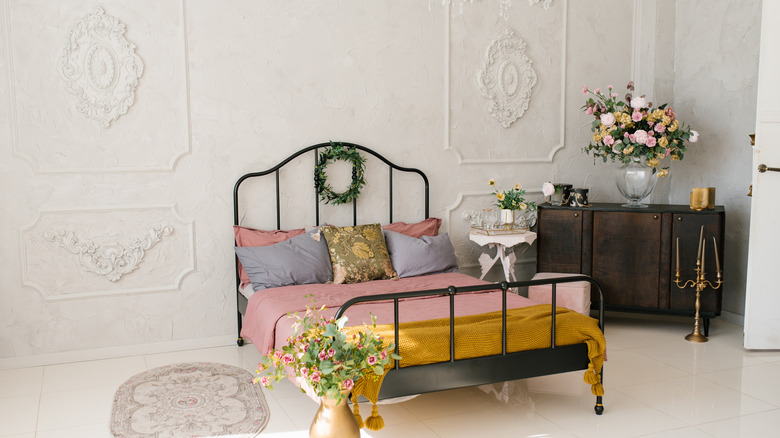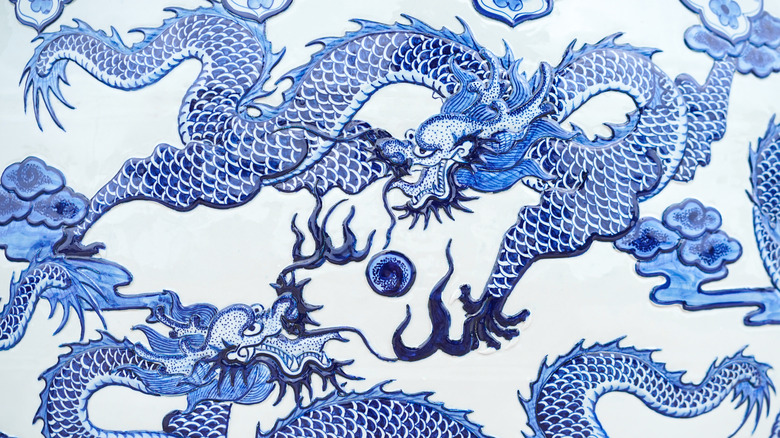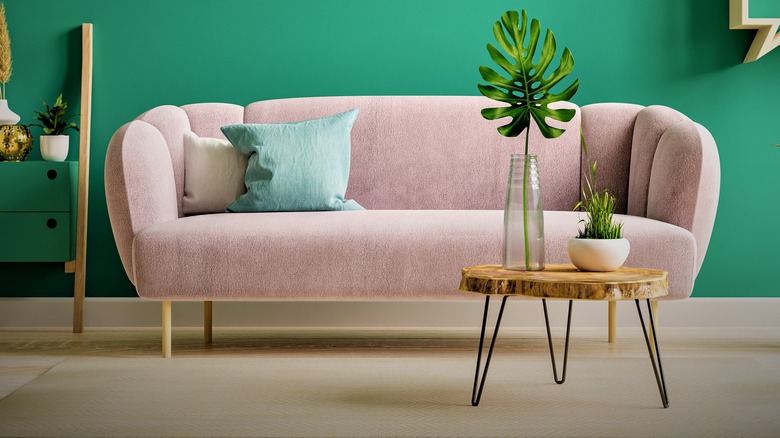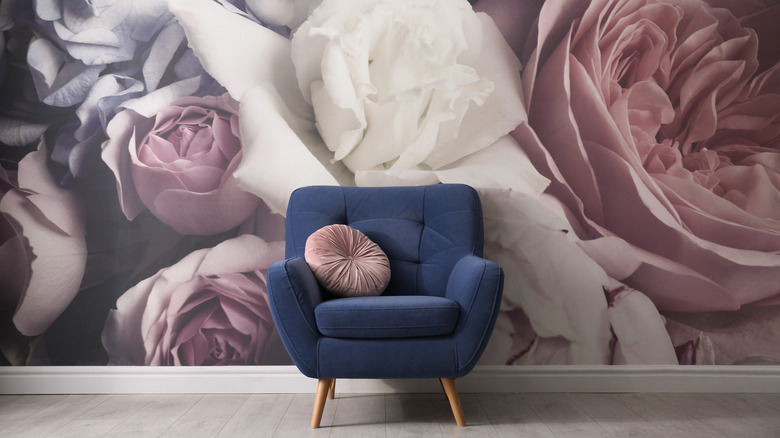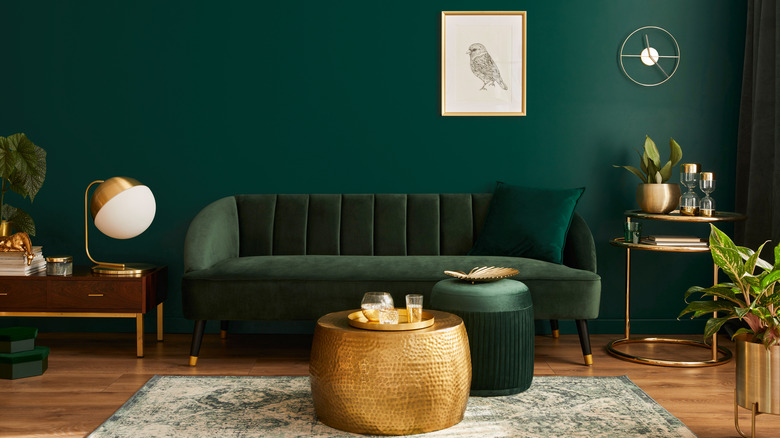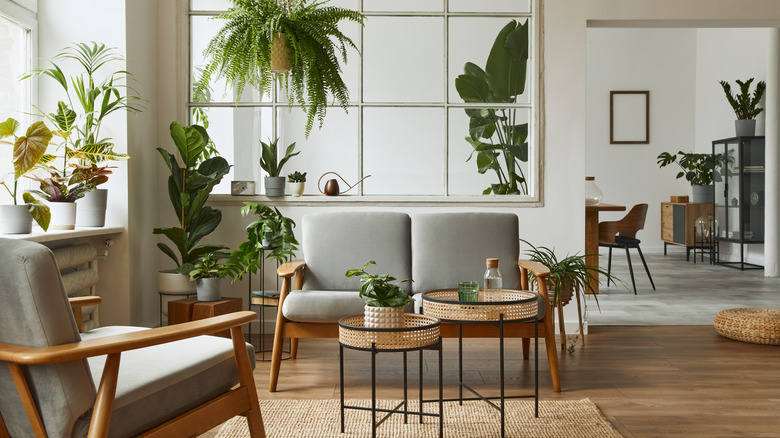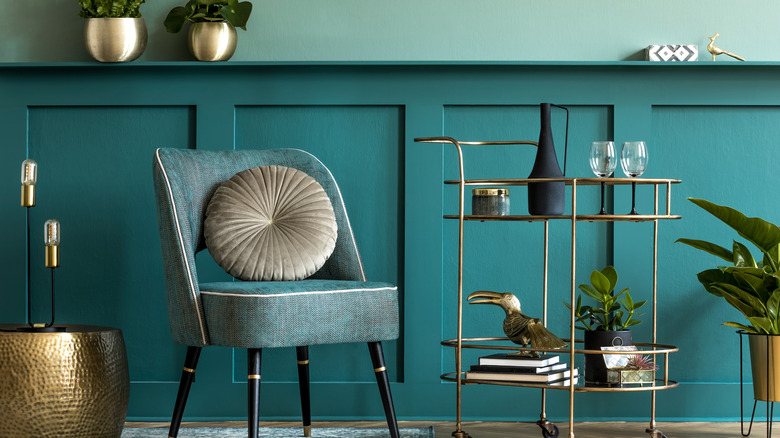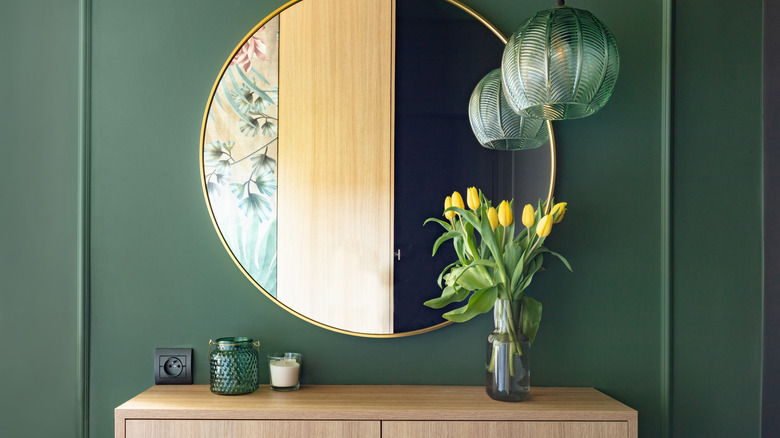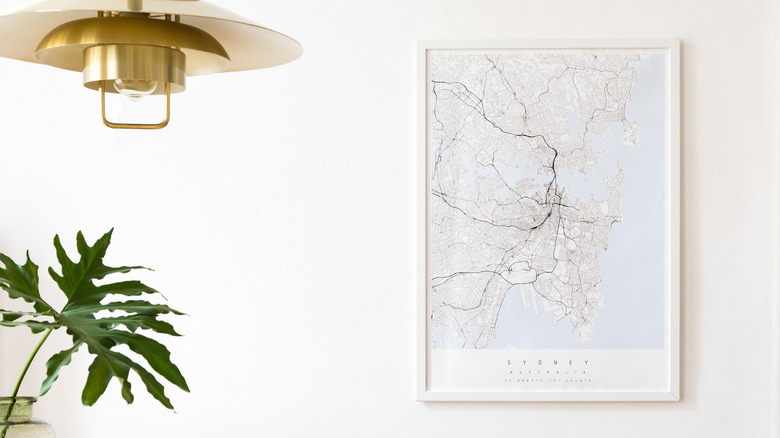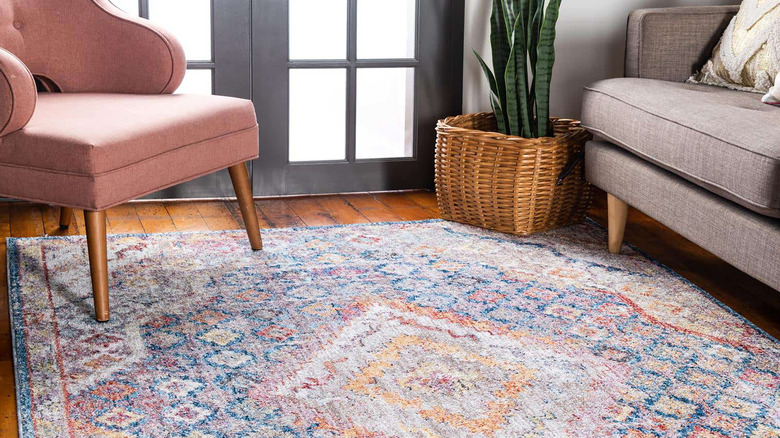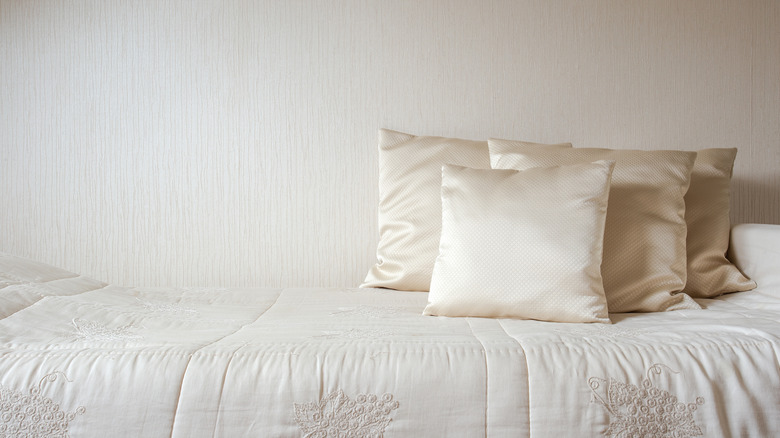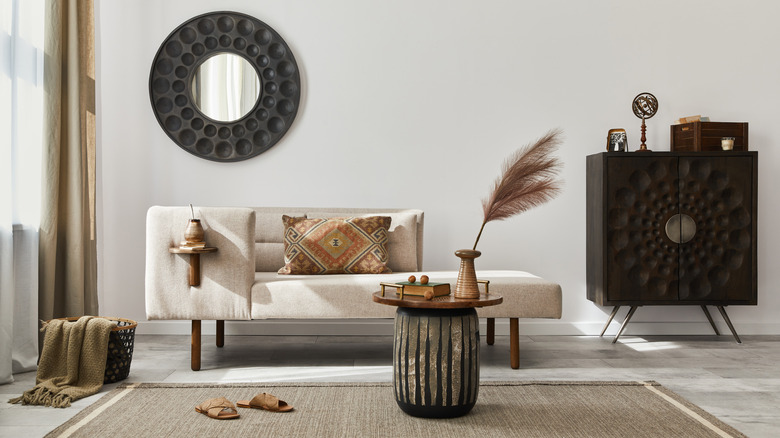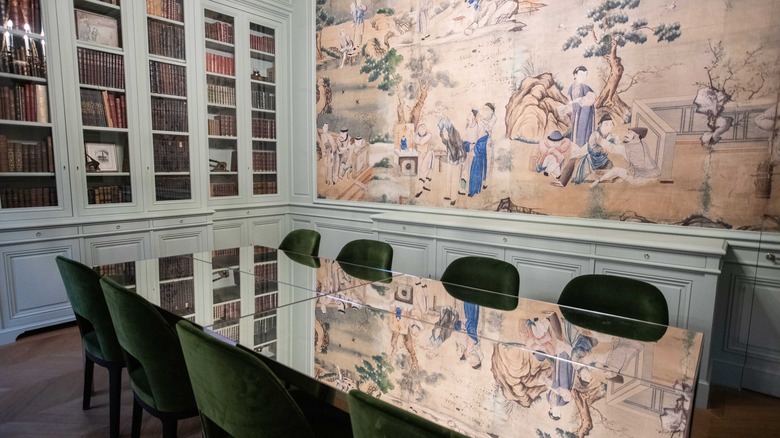The Ultimate Guide To Hollywood Regency Decor
Hollywood Regency, or Hollywood glam, is an American style of interior design that emerged in California during the 1930s. In this home design trend, designers drew inspiration from Golden Age cinema popularized in the 1930s through 1950s, which paid tribute to over-the-top concepts and Americanized worldviews. Because of emerging technology and formation of major production companies like MGM Films, Twentieth Century-Fox, and Paramount, films started to become art forms (via Arcadia Publishing). Films also started to incorporate sound and multiple angles into scenes, which allowed set designers to experiment with intricate details, textures, colors, and objects that would add visual interest to a scene.
According to The Spruce, Hollywood's hottest stars during this era started favoring the intricate details and wanted to incorporate it into their own spaces. Actors turned designers, like Dorothy Draper and William Haines, popularized the style with their audiences. To this day, Hollywood Regency has appealed to maximalists who love a vintage and glamorous feel.
Take inspiration from iconic 20th-century designers
Many coveted Hollywood Regency residential designers were film professionals, such as the debonair MGM art director, Cedric Gibbons, who had his home featured in Architectural Digest in 1992, and silent film star, William "Billy" Haines. Haines was silently pushed out by MGM Films because he refused to hide his homosexuality, even inspiring the Hays Production Code in 1930, which prohibited "homosexual behavior." According to Town & Country Magazine, before the end of his acting career, Haines partially owned a vintage shop and was a designer in a showcase. Because of his Hollywood connections, he quickly became one of the most sought-out decorators and catered to clients like Tallulah Bankhead, Jack Warner, and Betsy Bloomingdale.
Gibbons favored minimalist and modern lines that brought out architectural beauty. His spaces commonly featured greenery and white interiors and focusing on symmetric lines that were subtly placed. While Haines mixed Hollywood Regency with the popular 19th-century French Regency style of the time. Architectural Digest claims Haines was known for his blend of casual and formal styles and his own personal quirks, throwing color into every space he could.
By contrast, actress-turned-designer, Dorothy Draper, was known for her bold maximalist style that featured colorful stripes, loud patterns, and oversized flowers. According to NewWall, she's known for decorating many iconic interiors, such as the restaurant at the Metropolitan Museum of Art in New York, the Arrowhead Springs Hotel in California, and Hampshire House in New York.
Look to art deco design styles
Hollywood Regency and art deco were popular styles around the same time, which is why they often get mistaken for each other. Even though the styles have distinct differences, they blend together very seamlessly and compliment each other, making them perfect inspirations for each other. According to Mid-Century Modern Hub, art deco started in France in the 1920s but didn't reach the United States until the 1950s after World War II, while Hollywood Regency started in the 1930s in the United States.
Both styles use mixed woods and bright colors, and pay tribute to symmetrical bold lines, but Hollywood Regency is much more eclectic and animated than art deco. Both styles commonly use black and white in their color palettes and play with textures like fur, velvet, and silk. Additionally, these styles take inspiration from the neoclassical movement. Art deco is also known for its use of exotic materials such as mahogany, ebony, rosewood, ivory, and tortoise shell (via The Art Story). Today, this effect can be mimicked with stains on reconstructed veneers and vinyl.
Play with neoclassical elements
One of the most prominent inspirations for Hollywood Regency was the neoclassical movement. Neoclassicism was ushered in during the start of the 18th century enlightenment period in France. The movement itself took inspiration from the idealized image of ancient Greek and Roman art and culture, and welcomed a refreshed focus in the fields of science, history, mathematics, and anatomical correctness (via The Art Story).
These new interests are seen widely in neoclassical architecture and design, which valued functionality over vanity and was used as a tool to express political and social opinions. Neoclassicists believed art and design should stand for morals and virtues, improving viewers' lives. Excavations in Rome also produced artifacts that neoclassicists used as inspiration for decor. Inspired by ancient artifacts, neoclassical decor is known for its use of geometric shapes, animals and mythological creatures, festoons, ornamental vases, and straight tapering legs (via Invaluable).
Incorporate chinoiserie details
A commonly unknown style influence found in Hollywood Regency is chinoiserie, a decorating style that goes back to the 17th and 18th centuries. Chinoiserie is the American interpretation of Chinese and East Asian art, decor, textiles, and theater. Although the style interpretation was not historically accurate, it heavily influenced Hollywood trends and is still seen throughout the interior design industry today.
Because there was a lot less globalization and global reach in the 17th and 18th centuries, Europeans and Americans became fascinated with Chinese culture and art, especially porcelain and lacquer finishes (via House Beautiful). European manufacturers took note, and started producing designs that imitated a sort of pseudo-Chinese style — one that matched European tastes rather than focusing on cultural accuracy.
As a result of its popularity and ability to capture audiences, chinoiserie found its way onto screens during the Golden Age, and eventually into homes thanks to designers like Dorothy Draper who heavily favored chinoiserie fabrics, porcelains, and wall coverings (via Gracie Studio). The style embraced a worldly look, using bold color along with contrasting metallic and porcelain accents. It's also the inspiration for the iconic lacquered surfaces and bamboo shades and room dividers seen in Hollywood Regency. Key elements homeowners can incorporate are the use of dragons, florals, silks, foo dogs, nature scenes, and pagoda tiers (via Laura U Design Collective).
Figure out which elements you're drawn to
While Hollywood Regency is commonly associated with one look, it is an entire movement of design that has stretched from the 1930s to the present. Throughout this time, it has been adapted and altered. Additionally, many homeowners choose to customize the style themselves, blending it with boho or mid-century modern, or making it a bit more minimalist to fit a smaller space. Because of its long history, it's important to figure out which elements of Hollywood Regency you're uniquely drawn to.
While Hollywood Regency is known for taking inspiration from the Golden Age of Hollywood, it also takes inspiration from 19th-century Regency, which is a United Kingdom take on Egyptian, Gothic, Greek, and Roman architecture and overlapping movements like the Biedermeier style in Germany, Federal style in the United States, and Empire style in France. Like Hollywood Regency, the style focused on opulence and architectural details like columns and Roman arches. Additionally, both styles focused on bold colors, balanced design, mixed woods, expensive wallpapers, and antiquities.
Have fun with your wallpaper
Hollywood Regency is known for its bold color-printed wall decorations and hand-painted walls. An easy and renter-friendly way to get the same effect is to use either traditional pasted or peel-and-stick wallpaper. Originally, Hollywood Regency designers featured wall murals which were inspired by chinoiserie design. The designs featured Americanized versions of Asian landscapes, art, and animals. Today, designers commonly use bold botanical prints or art deco-inspired animal prints and patterns.
Home & Gardens suggests treating botanical prints as the focal point of a room, accessorizing around them, and making sure tones are cohesive. When decorating a Hollywood Regency room, many designers and homeowners also take wallcovering inspiration from the art deco period, focusing on dramatic colors or metallic chevrons, geometric shapes, sunbursts, and zigzag designs. These designs play at the neoclassical and modern elements Hollywood Regency is known for, while still being modern and highlighting your unique style. If you don't want to (or can't) go the wallpaper route, Town & Country Living suggests framing wallpaper or printed designs. This hack makes a very subtle statement piece and allows for easy blending of multiple interior styles into a space.
Accessorize with metallics
Because Hollywood Regency emulated high status and wealth, it highlighted cherished metallics such as gold and bronze. While these were difficult to duplicate in the 1930s, today we have the luxury of faux materials and paint. It's easier than ever to add gold into a space without overdoing it. Gold can be incorporated into a room through lighting, hardware, or furniture staples.
According to Houzz, gold and bronze can also be incorporated in small details like luxuriantly carved frames and mirrors, and lamps. These can be found secondhand vintage or in most big box home decor stores. While a touch of gold can absolutely make your decor feel luxurious, you'll want to avoid overdoing it, according to Apartment Therapy. Layering in gold accents via items such as side tables and accessories and mixing them with luxe fabrics will give you a space that is high-end, but not gaudy.
Incorporate wood veneers
Many key decor items from the original Hollywood Regency era used wood veneer in their builds. Furniture like tables, beds, and chairs were commonly decorated with wood veneer, either to mimic the look of exotic wood, for aesthetic design, or to keep costs low. According to Living Spaces, wood veneer is a thin slice of natural wood that is attached, through gluing or pressing, onto a panel of fiberboard or particleboard. Wood veneers are also less prone to warping and cracking, and require less maintenance. This solution is also available in a wide variety of woods, such as birch, oak, and acacia, which makes it the perfect solution for modern homeowners looking to incorporate Hollywood Regency into their home.
Homeowners can also repurpose existing pieces of almost any material to have the appearance of wood veneer by using a liquid wood paint composite, which can be applied to virtually any surface and stained like traditional wood. Because modern Hollywood Regency is an amalgamation of many different styles, homeowners don't have to worry about furniture not being the right style to fit the Hollywood Regency style. Hollywood Regency since its conception has always had roots in other diverse styles, allowing virtually any furniture to be adapted to Regency glam.
Forget minimalism
While designers like William "Billy" Haines were known for their more minimalistic approach to Hollywood Regency, designers like Dorothy Draper went full-out maximalist, showcasing antiquities and the wealth of individuals. Modern Hollywood Regency is usually associated with the style Draper made iconic, including her play on exuberant use of color, textures, and high glam. Draper went on record saying, "I always put in one controversial item. It makes people talk," when asked to describe her design style (via the Santa Cruz Sentinel).
Homeowners today can mimic the maximalism Draper and her fellow designers were known for, even on a budget. According to Apartment Search, homeowners looking to maximize their decor should use loud, repetitive patterns, layer items such as rugs, painting, and decor, and work in eye-catching statement pieces. While The Spruce suggests taking a page from Haines' playbook and incorporating plants, bold colors, prints, and textures to create a kaleidoscope of detail in a room. Isabel Ladd of Isabel Ladd Interiors told The Spruce, "Joy is a fundamental element of maximalist design because the vibrancy and energy that hits you when you walk into a well-decorated maximalist space should induce happiness."
To bring extra joy into their space, homeowners can purchase items they love to decorate bookshelves or entry tables. They can also repurpose items that may not traditionally work in Hollywood Regency with simple DIYs, such as applying gold leaf or using milk paint to achieve ceramic effects on any surface (via Collective Gen).
Layer in mirrored surfaces
Mirrors are a staple found in both traditional glam and Hollywood Regency interior styles, commonly the Georgian and Regency style of mirrors, that was heavily influenced by neoclassicism (via Bianca White Writes). These mirrors were often gold, bronze, or wood, and decorated with symmetrical ornamentation and neoclassical motifs, like garlands and simple scrollwork.
Mirrors are also great ways to bounce light in small spaces, especially if a room is filled with bold color or contrasting wallpaper. Many homeowners trying to incorporate Hollywood Regency into their home would benefit from using mirrored surfaces. Homes & Gardens states that homeowners looking to decorate with mirrors can use them as a backsplash in their kitchen, on a wall to accent mirrored furniture, as a headboard, or as a glam accessory on a coffee table. According to The Spruce, another way to incorporate mirrored furniture into Hollywood Regency is to decorate with glass chandeliers, star inlays, and mirrored-edged surfaces rather than fully mirrored surfaces. This allows light to flood into a space, while maintaining elegance and keeping things practical and timeless.
Play with Regency-inspired lighting
Lighting is a simple and affordable way to set the mood in any space. To bring a dose of Hollywood Regency into a room, homeowners can look to traditional Regency style to achieve the look. Because Hollywood Regency takes so much of its inspiration from the neoclassicism movement, these lighting fixtures are relatively easy to find. Neoclassical lighting in the 1930s through 1940s was known for its iconic gold features, symmetry, and elaborate ornaments, inspired by the Greek Revival (via Genuine Antique Lighting).
Additionally, because the Hollywood Regency style has spanned such a long time period, there are many vintage lamps available to purchase online. Hollywood Regency lighting is set apart with its unique metallic finishes, crystal or gemstone ordination, and its use of pops of color. Many fixtures also used amber glass to bring warm lighting into a space and play on color schemes, or used eccentric animal figures that were common in neoclassical styling (via Chairish).
Play with colors and patterns
Hollywood Regency is known for its iconic bold colors and patterns. Pinks, yellows, turquoises, golds, and emerald greens are some of the most popular hues in Hollywood Regency palettes. The style celebrates attention-grabbing colors, accents, and wall coverings. Throughout traditional Hollywood Regency, one can find porcelain textures, gold details, exotic furs and fabric, and boldly-colored items. When it comes to Hollywood Regency, the only rule about colors is that they should be bold and call attention to themselves, even in the case of minimalists like William "Billy" Haines, who was known for his pops of color and vintage eccentricity.
Better Homes and Gardens recommends pairing eccentric jewel-toned colors with neutral tones and accents to help a space remain calming, even if it's following Hollywood Regency decor. They also recommend using blue walls as a neutral against bold furniture, like chartreuse club chairs. Gold hardware and surfaces are also perfect for a bold room because contrasting wood can make a small space feel even more cramped.
Use textures in your space
Textures are a great way to further the style influence in a room and showcase the personality of those who live there. There are very few design styles that lend themselves to celebrating contrasting textures, no matter what they are, like Hollywood Regency. Because Hollywood Regency existed to showcase wealth in the 1930s through 1950s, it was common for homeowners to fill their rooms with exotic goods, materials, and fabrics. Whether it be neoclassical-inspired terracotta, gold, and woods, or chinoiserie-inspired silks, bamboo, and plants, it was fair game in Hollywood Regency.
Nowadays, homeowners can fill their spaces with leather and tufted sofas, or adorn their existing pieces with bold pillows, linens, and backdrops. According to The Spruce, one of the easiest ways for homeowners to incorporate texture into a room is by using a mix of textiles throughout multiple surfaces, like window treatments, throw pillows and rugs, bedding, and furniture upholstery. While many vintage art deco and Hollywood Regency pieces are available for secondhand purchase, homeowners can experiment with any textures they like, including leather, velvet, silk, bouclé, wool, cotton, linen, wood grain, and stone.
Play with flow and scale
While Hollywood Regency is known for being very bold, it's also a style that took scale and balance into consideration. According to Houzz, Hollywood Regency focused on being very practical despite its eccentric nature. Rooms were designed around parties, and focal points were the attending guests, not the pieces that were strewn around the room. The way Hollywood Regency designers achieved this look was to give special attention to the scale of items and their placement. Designers kept chairs and sofas low-slung and modest in scale so they didn't overshadow the guests seated on them. They also avoided placing all the furniture against walls and hard surfaces, instead opting to create a natural flow of movement in a space.
According to Moretti Interior Design, a great way to incorporate flow into a space is to pay attention to your sightline and visually link neighboring rooms and reflections with each other. Simple tricks like placing botanical wallpaper on a focal wall and a gold vase with floral stems in the adjacent kitchen can make two totally separate rooms cohesive. Another way to create cohesive flow is to use the same flooring throughout a space.
Use lacquered and high gloss surface
Because of its chinoiserie influence, Hollywood Regency homes were filled with high-gloss lacquered surfaces. It was common to see ultra-reflective walls, furniture, and decorative pieces artfully placed around a room. Jasmin Reese, who runs Jasmin Reese Interiors, told Livingetc, "I personally think that lacquered walls provide an element of allure and mystique. The light changes and reflects so beautifully on them throughout the day in natural lighting as well as incandescent lighting." Its ability to play up lighting allows highly lacquered walls to work well with bold and jewel colors, and in moody tight spaces. However, designers warn that lacquer finishing can showcase imperfections in walls and furniture very easily. While that is a great way to incorporate texture into a space, it isn't always the most beautiful interior design.
Nowadays lacquering your furniture and decor is as easy as can be. There are many consumer-grade products that contain nitrocellulose lacquer, the special lacquer used on pianos and instruments to maintain their high-gloss shine. According to Amy Howard Homes, all homeowners have to do is clean their chosen surface and follow the instructions on the product they're using, applying two coats and giving adequate dry time. Simple craft advances in paint technology have allowed anyone to adapt any of their decorative items to fit a Hollywood Regency style.
